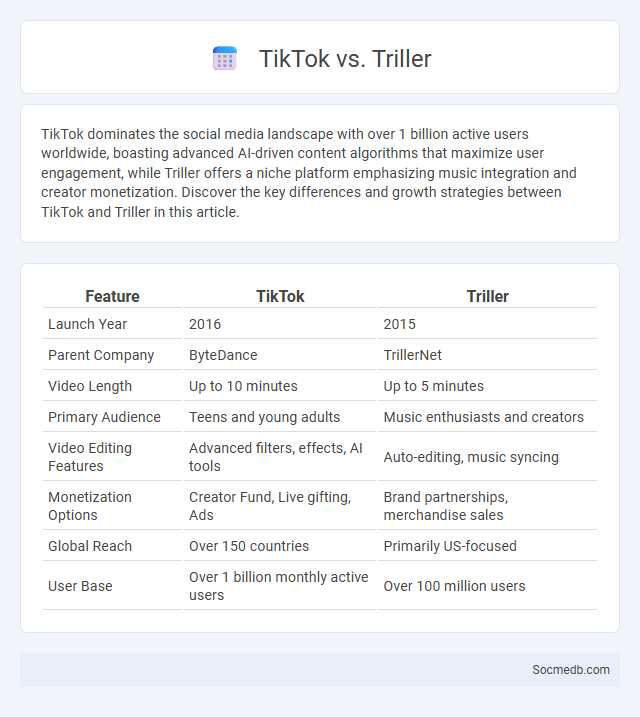
Photo illustration: TikTok vs Triller
TikTok dominates the social media landscape with over 1 billion active users worldwide, boasting advanced AI-driven content algorithms that maximize user engagement, while Triller offers a niche platform emphasizing music integration and creator monetization. Discover the key differences and growth strategies between TikTok and Triller in this article.
Table of Comparison
| Feature | TikTok | Triller |
|---|---|---|
| Launch Year | 2016 | 2015 |
| Parent Company | ByteDance | TrillerNet |
| Video Length | Up to 10 minutes | Up to 5 minutes |
| Primary Audience | Teens and young adults | Music enthusiasts and creators |
| Video Editing Features | Advanced filters, effects, AI tools | Auto-editing, music syncing |
| Monetization Options | Creator Fund, Live gifting, Ads | Brand partnerships, merchandise sales |
| Global Reach | Over 150 countries | Primarily US-focused |
| User Base | Over 1 billion monthly active users | Over 100 million users |
Overview of Short-Form Video Platforms
Short-form video platforms like TikTok, Instagram Reels, and YouTube Shorts have revolutionized digital content consumption by offering engaging, easily digestible videos typically under 60 seconds. These platforms leverage advanced algorithms to personalize content feeds, significantly boosting user engagement and retention. Their widespread popularity has driven brands and creators to prioritize concise, impactful storytelling to capture audience attention quickly.
TikTok: Features and User Base
TikTok offers a dynamic platform with short-form video content, featuring tools like filters, effects, and music integration that enhance creativity and engagement. Its algorithm-driven feed, known as the "For You Page," delivers personalized content tailored to your preferences, maximizing user interaction. TikTok's global user base exceeds 1 billion active users, predominantly aged 16-24, making it a powerful channel for influencers, brands, and marketers targeting younger demographics.
Triller: Unique Selling Points
Triller stands out in the social media landscape by leveraging AI-powered video editing tools that enable users to create professional-quality content effortlessly. Its emphasis on music integration and celebrity collaborations offers a dynamic platform for discovering and sharing trending audio clips. Your experience is enhanced through personalized content feeds driven by advanced algorithms that deliver highly engaging and tailored entertainment.
Audience Demographics Comparison
Analyzing social media audience demographics reveals significant differences in age, gender, location, and interests across platforms like Facebook, Instagram, TikTok, and LinkedIn. Your marketing strategy should align with these insights to target the most relevant user segments effectively. Understanding where your audience spends their time ensures better engagement and higher conversion rates.
Content Creation Tools: TikTok vs Triller
TikTok and Triller each offer powerful content creation tools designed to enhance your social media presence through intuitive editing features and AI-driven effects. TikTok provides a vast library of sounds, filters, and effects that allow users to craft viral videos with precise control over timing and transitions. Triller emphasizes automatic video editing powered by AI, enabling you to create professional-quality music videos with minimal effort, making it an excellent choice for users seeking quick, polished content.
Algorithm and Content Discovery Differences
Social media algorithms prioritize content based on user behavior, engagement patterns, and platform-specific signals, shaping what users discover daily. Platforms like Instagram rely heavily on machine learning to curate personalized feeds, while Twitter emphasizes real-time content relevance through chronological or engagement-based sorting. These algorithmic differences significantly impact user experience, content visibility, and overall content discovery dynamics across various social media channels.
Monetization Opportunities for Creators
Social media platforms offer diverse monetization opportunities for creators, including brand partnerships, sponsored content, and fan subscriptions. You can leverage tools such as YouTube's AdSense, Instagram's Shopping features, or TikTok's Creator Fund to generate revenue effectively. Maximizing your reach with targeted content increases audience engagement and boosts earning potential.
Cross-Platform Promotion Strategies
Cross-platform promotion strategies enhance your brand's visibility by leveraging multiple social media channels such as Instagram, Facebook, Twitter, and LinkedIn to reach diverse audiences. Utilizing consistent branding, tailored content, and strategic scheduling increases engagement and drives traffic across platforms. Implementing analytics tools allows you to track performance and refine campaigns for maximum impact.
Benefits and Challenges of Multi-Platform Content
Creating multi-platform content amplifies your social media reach by engaging diverse audiences across Facebook, Instagram, Twitter, LinkedIn, and TikTok. Leveraging platform-specific features enhances brand visibility and drives higher user interaction, boosting overall marketing effectiveness. Managing consistent messaging while adapting to each platform's unique style and algorithm remains a key challenge for content creators.
Choosing the Best Platform for Your Brand
Selecting the best social media platform for your brand depends on understanding your target audience's demographics, preferences, and online behavior. Platforms like Instagram and TikTok excel for visually-driven, younger demographics, while LinkedIn is ideal for B2B networking and professional content. Analyzing platform features and engagement rates helps maximize brand visibility and aligns marketing strategies with business goals.
 socmedb.com
socmedb.com